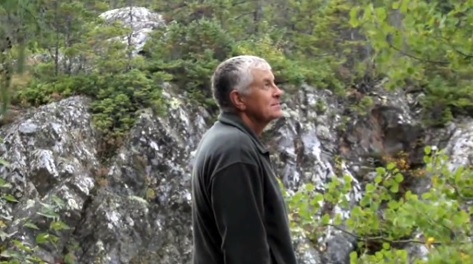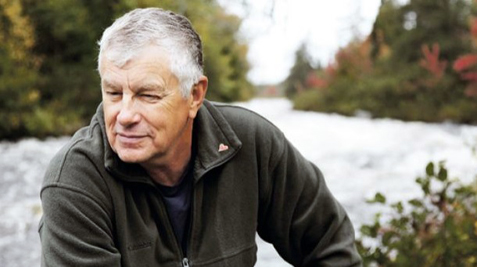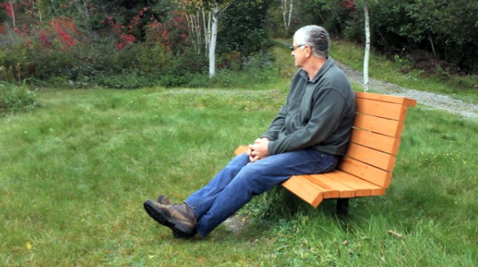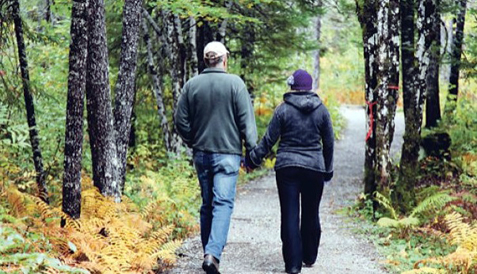



Living with death a brush with the afterlife
In 2006 Norman died of a heart attack while doing landscaping work. He flatlined and had no heartbeat for an incredible 15 minutes. During that time he remembers floating up into the air and meeting a man eight or nine feet tall who guided him. All the while he felt at peace and wasn't scared. As remarkable as Dan's story is, it was not the only time he had a brush with death. |
 |
 |
 |
 |
Above photos are of Dan Norman and his wife, Katty, who enjoy every moment they spend together.
December 28, 2013 - Reported [here]. The Telegram’s Rhonda Hayward captured Dan Norman’s near-death experience. The Telegram asked its team of photojournalists to pick one image from 2013 that meant the most to them. Here is Rhonda Hayward’s selection: One of the most fascinating assignments I worked on over the past year was a series about living with death, with arts and life reporter Tara Bradbury. In 2006 Norman died of a heart attack while doing landscaping work in Gander. He flatlined and had no heartbeat for an incredible 15 minutes. During that time he remembers floating up into the air and meeting a peculiar character eight or nine feet tall who guided him. All the while he felt at peace and wasn't scared. As remarkable as Dan's story is, it was not the only time he had a brush with death. When he was 17 he almost drowned in a boating accident. Hearing him tell the tale of how he survived both incidents and how, as a result, he has a new appreciation for life and nature, and how he feels he has a definite purpose here on Earth, was truly inspiring.I chose this photo of Dan and Katty walking down a path in the forest. After all, no one really knows what lies down the path for all of us.
October 12, 2013 - Reported [here]. Dan Norman’s near-death experience. Living with death a brush with the afterlife. Dan Norman is the kind of guy you meet and you feel you’ve known all your life. A salt of the Earth type, he’ll take his ball cap off only if he must, and is quick with a witty one-liner or a playful, tormenting remark. Norman is a retired teacher and a musician who, at age 63, spends a lot of his time outdoors near Gambo, where he grew up and still lives with his partner, Katty. If he’s not working on his antique Pontiacs in the shed, he’s working in the garden or out on the water or chopping wood. One of his favourite pastimes is simply sitting on a bench along the Middle Brook trail, drinking in the smell of the woods and the glint of the water in the sun, marveling at the perfection of life, from the tiniest insect to his own. He often wonders what the plan is for him, and if there’s something specific he’s meant to do. If he had been dead a little longer, he says, he would have tried to find out. In 2006, Norman died of a heart attack. Doing some landscaping at Gander’s Lakeside Homes nursing complex at the time, he hadn’t been sick and had no history of heart trouble. Loading up his truck and bringing the dog along for company, he set out for the home that morning feeling fine. While using a ride-on lawn mower to cut the grass at the back of the home, Norman says he started to feel nauseous and dizzy. He turned off the mower and began walking towards the building. He says he saw a man standing facing the wall, about eight or nine feet tall — but at the time, Norman didn’t find it peculiar. “His hair was straight and long and dirty blonde, almost like it was a wig or something,” he recalls. “He had a long, tan colour robe that was hanging down about 10 inches from the ground, and he had a rope around his waist, like you see in the Bible or something like that. He never said anything, but I knew he was talking to me. He said, ‘If I were you, I’d go around to the front because no one’s going to see you back here if anything happens to you.’ I thought, if he thinks it’s that serious, perhaps I should go around to the front." Norman says he remembers taking a few steps away, then turning back — Gander is a relatively small town, and he didn’t recognize the man, so he was curious. “I turned around and I said, I’m going to be brazen and ask, who are you, anyway? He was still looking at the wall and then he turned to his left, right around like he was on a turntable. He said, ‘I look after the people.’” When the man turned, Norman says, he had only indents where his facial features would have been. His face was like a tangle of fine wire or steel wool, in pulsating shades of red. Again, Norman says he didn’t find it strange at the time. Norman kept walking to the front of the building, where he picked up his Whipper Snipper and began trimming the grass around a large spruce tree at the entrance. That’s where he fell down, he says, dead. A nurse from inside the home happened to be looking out her window, and saw Norman fall. She called for a colleague and the pair summoned an ambulance and rushed to start CPR while waiting for it to arrive. “The next thing I know, I can remember being up in the air like that,” Norman says, raising his hand. “This guy that I saw around the building, he was floating on up in the air (too). “I was floating along and I wasn’t scared or anything, and I happened to look down. I knew I was me and I knew I had arms and legs and everything, I was just floating up in the air. I could see people standing around and the roofs and the vents and the trees and all that stuff. I said to buddy, how can you be up there and down there, too? When I said that, I looked down again … and I said, sure that’s not you, it’s me. I got a big fright because I recognized myself down on the ground.” While he was floating, Norman says, he had the most peaceful, happy feeling. He remembers being able to instantly transport himself wherever he wanted, simply by thinking of the place. He felt he was flittering around like a butterfly. At one point, he recalls hearing the voice of his cousin’s husband, who had died two years previously. “Go back!,” he was saying angrily. The next thing Norman knew, he was waking up in hospital, his three sons at his bedside. In reality, some time had passed, because at least one of his sons had traveled from Alberta to be at the hospital, after receiving the phone call about what had happened. “They told me I had flatlined, no heartbeat at all for 15 minutes, and it was a miracle I was alive at all,” Norman says. The nurses had continued doing CPR on him until an ambulance arrived. Paramedics tried using the defibrillator paddles on him a number of times, to no avail. At the hospital, doctors tried again with no luck. “He still couldn’t get anything. Then he said, ‘I’ll try one more time, there’s a little bit of life there, a little bit of electricity.’ And (my heart) started.” Norman’s family doctor, Dr. Emad Kamel, says there is a medical explanation for what Norman experienced, although why he had the exact visions he did is a mystery. When a person dies, Kamel said, they stop breathing and then their heart stops. At that time, the brain can still function for a maximum of about two minutes or so. Certain Canadian and Romanian studies have shown that tactics like lowering a person’s body temperature at that point in time can allow the brain to function longer, perhaps an hour. “After the blood supply stops, it doesn’t mean cells are dead,” Kamel explains. “Certain areas remain alive for some time, and medically speaking, scientifically speaking, the brain might gather dreams.” The brain is complicated, and dreams people experience that seem to last for hours actually only take a few seconds, Kamel says. “When they resuscitated him and he survived, the brain started to burst out what he had collected during that dream.” Norman may have seemed dead for 15 minutes, the doctor says, but in reality, there would have been faint heart activity for all but a minute or two. Most people who die and are brought back to life have some sort of brain damage. “It’s in the minority of cases that a person would survive and get everything back completely like Dan,” Kamel says. Kamel believes his patient saw a glimpse of Heaven. “Myself, I believe it very much. People may see Heaven, but it needs faith.” The heart attack was Norman’s second brush with death: as a 17-year-old, he nearly drowned in a boating accident at Barachois Provincial Park, and recalls seeing a bright light, and feeling happy and warm. “It felt like all the love of everybody in the world, everybody I knew, was hugging me,” he remembers. “Then it disappeared and I was walking in the water on the shore. I don’t know how I got out of the water.” Norman’s 15-year-old nephew drowned in the accident. Norman acknowledges his experiences may be put down to a lack of oxygen or a drop in blood pressure, but says as far as he is concerned, what he saw and felt was very much real. He doesn’t know who the man outside the nursing home was, but has been doing a lot of research in an effort to get some answers. He wears an implanted defibrillator these days, and it was activated just once, in April last year. In recognition of that, he wears a small heart-shaped pin on the collar of his fleece jacket. Norman plays keyboard, guitar and bass, and has taken up writing songs, and has recorded two CDs in the past couple of years: “There Are Angels,” a gospel album, and “The Real Deal,” a light-hearted record which he released over the summer. He says he’s never been a very religious man, but his close calls with death have changed his life. “I want to take advantage of things that I didn’t realize before, like how beautiful everything is. I was in hospital in Gander for a month and when I opened the door to go outside, somebody had just cut the grass and I could smell it. It was beautiful, the smell of grass. Little things, like a flower or a snail or a grasshopper — it’s all so beautiful.”
|